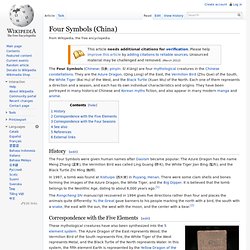

Hidden Meaning of Symbols. The Eight Immortals (八仙) are eight daoists who have attained immortality and include: 1) Han Zhongli (汉钟离), also known as Zhongli Quan (锺离权), was a Han Dynasty general and is usually shown carrying a feather fan which he uses to revive the dead. 2) Lu Dongbin (吕 洞宾), known for his drinking and fighting abilities, carries a demon-slaying sword.

He also carries a fly whisk which he uses to walk on clouds, fly to heaven, and sweep away ignorance. 3) Zhang Guolao (张果老) rides a donkey, sometimes seated backwards, and carries a tube-shaped bamboo musical instrument called a yugu (鱼鼓). 4) Li Tieguai (李 铁拐), known as "Li with the iron crutch", is a crippled beggar who carries a gourd filled with a magic elixir. 5) He Xiangu (何仙姑) is the only female in the group and usually carries a kitchen ladle, lotus, peach or fly whisk. 6) Han Xiangzi (韩湘子) carries a flute and can predict the future and make fruits and flowers grow out of season. Chinese Fables. Four benevolent animals. The Four Benevolent Animals (simplified Chinese: 四灵; traditional Chinese: 四靈; pinyin: Sì Líng) are figures from Chinese mythology that took abodes within the gardens of the palace of the Yellow Emperor.[1] They included: the Qilin (麒麟), the lord of furry quadrupeds;the Dragon (龍), lord of scaly animals;the Turtle (龜), lord of shelled animals; andthe Phoenix (鳳凰), lord of birds.

They were juxtaposed with the "Four Perils" (四凶, Si Xiong), which were ambiguously described in the classics as monsters, barbarians, or circumstances. See also[edit] References[edit] Chinese Mythology Clarified by Miao Legend Confirms Noah’s Flood History! Every school-child in China, Taiwan and other Chinese places, learns already early on about their original Chinese patriarchs and their histories.

But the most ancient Chinese history has become quite embellished over 4 1/2 thousand years and changed into mythology. As a result the 21st Century Chinese are quite confused about their earliest primo-genitors, and if it weren’t for a very interesting discovery that this article reveals, their earliest patriarchs would have stayed obscure until the end of time.
中國神話的苗族說明證實了諾亞洪水的歷史 Fu Xi and Nü Wa pictured with dragon tails intertwined. Picture by Ma Lin 160 AD The “Sān Huáng Wǔ Dì” The earliest records speak of “Sān Huáng Wǔ Dì”, meaning the “Three August Ones, or Three Sovereigns or Kings” and the “Five Emperors.” The three Sovereigns are generally denoted as Fu Xi, Nü Wa, and Shen Nong Shi, but in other literary sources Nü Wa is often replaced by Huang Di, one of the five Emperors. HUANG DI (Emperor Huang) FU XI & Nü-WA Now here’s the corker! Chinese dragon. Chinese dragons traditionally symbolize potent and auspicious powers, particularly control over water, rainfall, hurricane, and floods.

The dragon is also a symbol of power, strength, and good luck for people who are worthy of it. With this, the Emperor of China usually used the dragon as a symbol of his imperial power and strength.[1] In Chinese daily language, excellent and outstanding people are compared to a dragon, while incapable people with no achievements are compared with other, disesteemed creatures, such as a worm. A number of Chinese proverbs and idioms feature references to a dragon, for example: "Hoping one's son will become a dragon" (望子成龍, i.e. be as a dragon). Stone relief of Chinese dragons in the Qishan Wanfo Temple (Qishan Ten Thousand Buddhas Monastery), Fuzhou (1951).
Symbolic value[edit] Historically, the dragon was the symbol of the Emperor of China. The dragon is sometimes used in the West as a national emblem of China. Regional variations across Asia[edit] Four Symbols (Chinese constellation) The Four Symbols were given human names after Daoism became popular.

The Azure Dragon has the name Meng Zhang (孟章), the Vermilion Bird was called Ling Guang (陵光), the White Tiger Jian Bing (監兵), and the Black Turtle Zhi Ming (執明). The Rongcheng Shi manuscript recovered in 1994 gives five directions rather than four and places the animals quite differently: Yu the Great gave banners to his people marking the north with a bird, the south with a snake, the east with the sun, the west with the moon, and the center with a bear.[2] A Han-dynasty pottery tile emblematically representing the five cardinal directions The four beasts represent a season each.